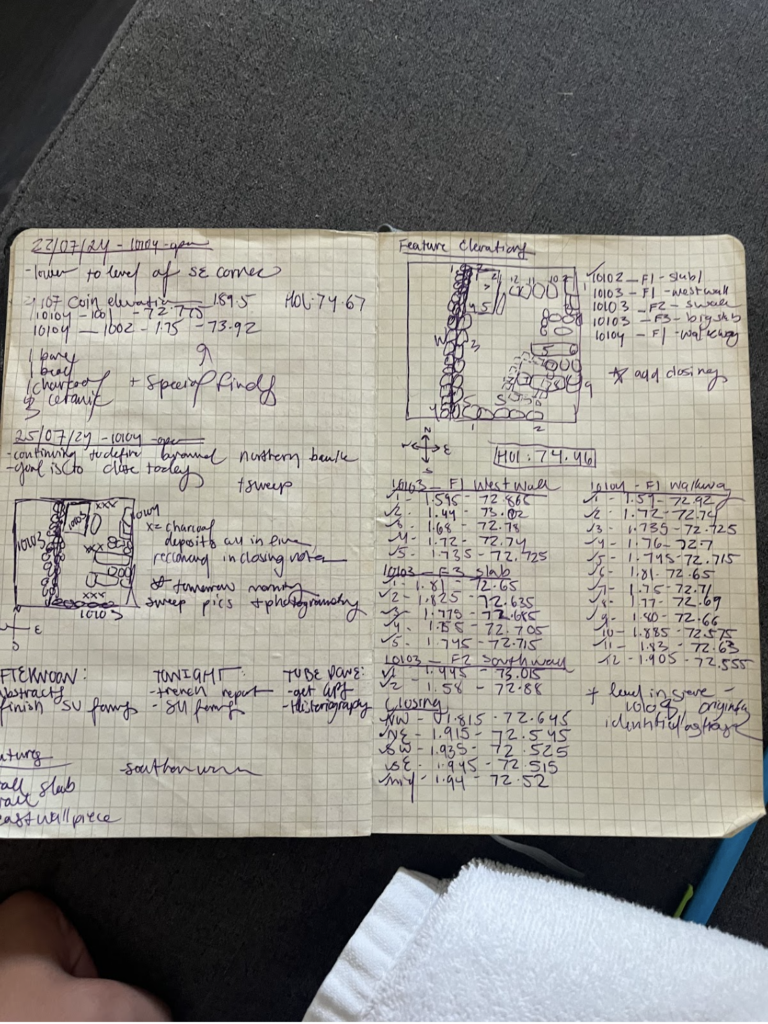Ella Arnold
We finished our excavations in EU 30 this week! Though Paris and I are both disappointed that our lofty goal of digging to the level of bedrock in our trench did not come to fruition, we were able to turn up so many amazing artifacts and uncover multiple “features” in the trench. The last time I wrote, we were still excavating SU 10102. At the time, the most notable aspect of 10102 was the “plastery gypsum” slab that we uncovered in the southeast of the trench; we made the decision to articulate around the stones that we noticed running both north-south and east-west in the eastern and northern portions of the trench respectively and then close the unit. After doing so, we opened SU 10103. We initially intended the unit to be exclusively the area under the slab feature, which we carefully articulated around and then removed at the beginning of our 10103 excavations. However, once the slab was removed, we were unable to note a change in soil, and there were no notable finds beneath besides one (admittedly super cool) bronze fish hook, we developed a plan to remove approximately ten centimeters of soil to the depth of the pit beneath the slab feature.

As the soil continued to be removed, a large stone to the northeast of the trench abutting the baulk was exposed, as well as a large, deeply rooted stone near the southeast of the baulk. Our prediction of a north-south running wall to the west of the trench was confirmed, and we also revealed a consistent, linear cluster of stones near the southern baulk running east-west that seemed more like tumble/fall. We also found baulk-inlaid stones on the southern edge of the trench that we could more confidently call a wall feature because of its visible stacked stones. On its northeastern end, we articulated around a stone running into the baulk, which was deeper than we had assumed when it made an appearance in SU 10102. As we began to articulate along both the confirmed “western wall,” we came down on a smooth, white surface, covered by a more compact soil layer. Initially, we believed this to be where the bedrock in the EU began, despite our excavation processes being very early on. We proceeded with carefully scraping back the mudbrick on top of the compact soil layer, which we determined to be our first floor surface due to a perceived soil change and larger sherds of flat-lying ceramics being turned up in the mudbrick. Further excavation eventually revealed that, instead of being bedrock, what we had encountered was another plastery gypsum slab, directly abutting the wall along its external northeastern side. Its base was approximately level with the bottom of the space beneath our first slab; as a result, we proceeded with the previous plan to bring the trench down to that arbitrary level.
Once 10103 was closed, we opened SU 10104. 10104 was sectioned off on the east side of the “western wall” and defined as its own SU, comprising about 2/3rds of the original trench area. We took down the floor layer that was on top of our second plastery gypsum slab while articulating along the two walls in the unit, seeking to reach the level of the base of the second slab. As we got deeper, we realized that the northern tumble/fall was actually fall laying on top of more deeply-rooted stone, which is a mystery for next year’s participants to uncover. Furthermore, we uncovered several long gypsum slabs, as well as a pit alongside the deeply-entrenched northeastern rock from 10103, which altogether became known as the “walkway” feature. On the last day of excavation during sweeping, we found a parallel, north-south pattern of charcoal burn spots–a conundrum I cannot wait to find out more about.

It was at this point that July began to draw to a close, and along with it, the excavation season. Hopefully, with the amount of soil that Paris and I were able to remove and the degree to which we were able to articulate our features, next year’s dig will move more quickly and yield even more awesome finds.
